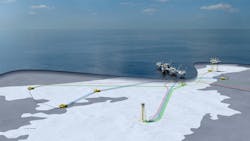North Sea Sverdrup construction picking up following coronavirus easing
Offshore staff
STOCKHOLM, Sweden – Lundin Energy has issued an update on its ongoing development programs in the Norwegian sector in its latest trading statement.
At the Equinor-operated Johan Sverdrup complex in the North Sea, Phase 1 production reached the plateau level of 470,000 b/d in April.
Now that there is sufficient well capacity, the partners plan to test the limits of the facility above this current capacity, with testing due to take place later in 2020.
As for Phase 2, construction continues on the second processing platform topsides and jacket, the new modules to be added to the existing riser platform, and the additional subsea facilities.
From mid-March, progress was impacted by the coronavirus situation, but activity is now increasing and 4Q 2022 remains the target for first oil.
At Lundin’s Edvard Grieg in the same Utsira High region, reservoir performance continued to exceed expectations, with limited water production and the total well potential higher than the available facilities capacity.
Results from a repeat 4D seismic survey over the field, designed help to optimize an infill well program, suggest that the water flood front continues to be further from the producing wells than anticipated.
Lundin is presently updating the reservoir model to reflect the positive field performance and to hopefully support a reserves upgrade and a further plateau production extension.
After down-manning the platform in March in response to the coronavirus, the company started a return to normal staffing levels in June. A planned maintenance shutdown will go ahead during the current quarter, and the jackup Rowan Viking should now start a three-well infill campaign on the Grieg field next spring.
Also under way is the Edvard Grieg electrification project, which involves retiring the platform’s existing gas turbine power generation system; installation of electric boilers to provide process heat; and installation of a power cable from Johan Sverdrup to Edvard Grieg.
As for the Solveig Phase 1 tie-in to the Grieg complex and the Rolvsnes extended well test, all production and injection pipelines have now been installed, and the semisub West Bollsta should start development drilling early in 2021.
Solveig Phase 1 is currently more than 40% complete and the Rolvsnes EWT project 65% complete. Rolvsnes’ deferred first oil has been advanced from 2Q 2022 to 3Q 2021, in order to obtain the reservoir data in sufficient time to support a potential full-field development decision.
Last month Norway’s government announced temporary tax incentives to stimulate offshore project activity: these apply to plans for development and operation submitted for approval before the end of 2022.
Lundin has identified up to eight potential projects that could be advanced to take advantage of the measures, the main ones being Solveig Phase 2/Segment D, Rolvsnes Full Field, Iving, Alta (Barents Sea) and the Alvheim Area projects of Kobra East/Gekko and Frosk.
The company will seek to speed up appraisal and field development studies in all cases with a view to maturing them to PDO status within the given timeline.
Over the remainder of 2020, Lundin expects to drill four exploration wells offshore Norway targeting net resources of more than 350 MMboe. The West Bollsta will drill three of the wells (all operated by Lundin).
Finally, the company received approval last month from the UK authorities for its decommissioning plan for the trans-North Sea median line Brynhild field. Approval should come through shortly from Norway.
The Rowan Viking started abandonment of the four subsea wells in May. DeepOcean should begin removing the subsea facilities next summer.
07/29/2020



